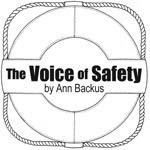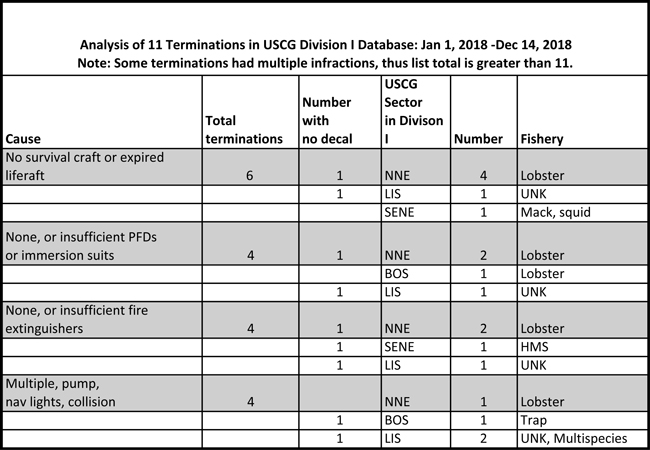Count Down on 2018 Terminations
by Ann Backus, MS

When I looked back to see what I had written for the Voice of Safety, Forum article in March 2018, I saw it was about life-raft servicing. So I decided to follow-up to see what the situation was in 2018 regarding terminations – life-raft related and others.
The regulations regarding terminations can be found at 46 CFR Section 28.65. “A Coast Guard Boarding Officer may direct the master or individual in charge of a vessel, with the concurrence of the District Commander, or staff authorized by the District Commander, to immediately take reasonable steps necessary for the safety of individuals on board the vessel if the Boarding Officer observes the vessel being operated in an unsafe manner and determines that an especially hazardous condition exists. This may include directing the master or individual in charge of the vessel to return the vessel to a mooring and remain there until the situation creating the especially hazardous condition is corrected or other specific action is taken.” This regulation applies to commercial fishing vessels.
The good news is there has been a positive and marked downward trend in terms numbers of U.S. Coast Guard (USCG) terminations in Division I over the last four years. Coast Guard Incident database reports 18 terminations in 2015, 24 terminations in 2016, 29 terminations in 2017, and 11 terminations in 2018. Now whether this trend is related to external factors such as USCG budget, administrative policy, or availability of personnel, etc. I cannot know, but the actual numbers are down, and that is commendable.
The following spreadsheet will be the basis for the remainder of the article.

There were 18 infractions associated with the 11 vessel terminations. From the spreadsheet we can see that missing and expired life rafts are the most frequent reason for terminations. Six of the 18 infractions for terminations were related to life rafts. Compared to prior years, life-raft terminations made up 54% of terminations in 2018, 36% in 2017 and 54% in 2016. And we should keep in mind that while we had many fewer terminations in 2018 than in the prior years, life-raft terminations still made up 54% of all terminations.
Two of the 6 vessels cited in 2018 for life-raft infractions did not have decals. These vessels either had not had, or not passed, a dock-side exam.
Four of the 18 infractions for termination involved PFDs and immersion suits and again two of the vessels cited did not have decals. Four of the 18 infractions were for missing or an insufficient number of fire extinguishers. In this case, three of the four vessels did not have decals.
Finally, I lumped together infractions listed as “multiple” infractions, non-working pump, missing navigation lights, and collision. There was one of each for a total of four. Two did not have decals.
In the Sectors, Long Island Sector (LIS) has the most infractions (4), with Northern New England (NNE) following closely with three. It is in the fishery column that we see the greatest difference. Ten of the 18 infractions are attributed to the lobster industry. That comes out to 61%. Clearly more work needs to be done with this industry; they also had 66% of the life raft infractions.
Except for the life-rafts and life-raft servicing, all the items required for compliance are individually priced between $50 and $500. For most fishermen, these prices are considerably less than cost of missing a day of fishing due to termination.
Cutting down on terminations
Probably the most effective means of cutting down on terminations is to schedule a dockside exam. Your local sector office will be glad to schedule this exam. From the USCG database it appears that 50% of the infractions of 2018 would have been caught during a dockside exam. If the vessel passes the dockside exam, a decal is issued. A vessel with a decal less than two years old, if boarded “can expect abbreviated boarding times.” A vessel with an expired decal is generally issued a warning and required to get a dockside exam within 30 days.
Although not mentioned in this analysis, making sure your EPIRB is registered (every two years) and has a working battery will also help you avoid a termination.
Again this year, the recommendation is to take the time to get your life raft serviced. It will pay –off in the long run and perhaps provide a little peace of mind as well.
Ann Backus, MS, is an Instructor in Occupational Safety and Director of Outreach in the Department of Environmental Health at the Harvard T.H. Chan School of Public Health, Boston, MA. She may be reached by phone at (617) 432-3327 or by email at abackus@hsph.harvard.edu
